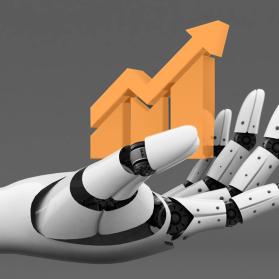Digitalization has made rapid progress in recent years and extended its impact to all aspects of our society — including the public sector. At this year’s conference on the “Digital State”, the development of digital administration in Germany was examined in detail. Especially close attention centered on topics such as cloud transformation, the use of artificial intelligence (AI), data analytics, and sustainability, just to mention a few.
Everyone is talking about a “turning point” in public administration — one that is expected to create new opportunities for the improvement of services for citizens and to play a part in promoting sustainable practices. This “commentary” invites readers to consider critically the above-mentioned topics and presents various options for action leading to digitally transformed and sustainable public administration in Germany.
Cloud transformation in the public sector: a turning point in public administration?
The changeover to cloud-based services represents a paradigm shift that will fundamentally change the way services are performed and used in the public sector. In times of fast-moving technology, cloud services have the potential to improve the efficiency, scalability, and flexibility of public administration. At the same time, they are the gateway to innovative ideas during our search for solutions to the challenges facing society and contribute to heightened satisfaction of citizens as the latter’s demands converge more and more on “digital first.”
The conference “Digital State” highlighted various aspects of cloud adoption in the public sector, including technology adoption, data privacy and security, personnel development, and systems interoperability. Yet participants did not shy away from discussing the hurdles associated with cloud integration.
- How much sovereignty is needed?
- How much public cloud is possible?
- To what extent can multicloud approaches, e.g., a mixture of public, private, and hybrid cloud services, also be integrated into public administration structures?
These and other questions should be considered separately and addressed according to the specific context of each case.
Beyond these deliberations, the cultural component must not be ignored. Fostering a culture of change readiness and continuous learning is critical for the creation of acceptance and securing people’s commitment to the transition to cloud technology. Change management techniques, training programs, and agile and collaborative working methods are recommended tools.
Discussions during the “Digital State” conference clearly demonstrated that the transformation of the public sector in the direction of the cloud is already in full swing. The task now is to support and continuously drive this process forward so that the public services of the future become more digital, more user-friendly, and more accessible to citizens.
Artificial intelligence and data analytics: How can data improve decision-making?
During the move to the cloud, huge amounts of data that can be used for data analytics and artificial intelligence (AI) are generated and stored. Generally speaking, public organizations acquire the ability to identify patterns in their data, make predictions, and base their decisions more solidly on facts than ever before.
ChatGPT has boosted interest in AI solutions in public administration as well. A prerequisite for the use of AI is the availability of good-quality data in a machine-readable format. Data-driven government or data-driven administration is an important element for the meaningful use of AI in administration. AI can create automated processes of greater efficiency for the support of employees in public administration. The Federal Ministry of Finance (BMF) uses AI for the analysis of large data sets and other tasks. AI is already being used today in several federal ministries, where chatbots communicate with citizens. Large language models, a special form of AI, have in particular the potential to improve the quality of conversations with chatbots in public administration.
The use of AI in public administration requires a high level of data protection and trustworthiness. There are ethical and legal risks associated with the processing of citizens’ data and classified information. Ministerial guidelines for the use of AI and on-premise solutions for data processing of documents requiring special protection are one means of ensuring the secure use of AI in administration.
The discussions at the “Digital State” conference revealed that the quality of the data in public administration is inadequate for use with AI as of the moment. At this time, there is often no holistic overview of existing data (e.g., held by a government authority) or data are not even being collected. Important steps for changing this situation are the further development of data literacy in public administration and the dismantling of organizational silos. The processes now being used by employees must be recorded and optimized before they can subsequently be realized as a digital solution or for use with AI. Intelligent process design and management are prerequisites for achieving these goals.
The introduction of AI in administrative processes should be a gradual process carried out in close collaboration with employees. The basis for successful AI implementation is users’ trust in the digital solution. The introduction of guidelines for the development and use of AI solutions (digital ethics framework) ensures compliance with ethical and legal principles. In addition, the high quality of data that are readable and interpretable for machines must be ensured. Pilot projects can serve as trial rollouts to test the effectiveness of the solution within the administration before it is rolled out throughout the organization.
Sustainability: Is a climate-neutral administration possible by 2030?
AI and data analytics can be used to drive sustainable solutions in the public sector. For instance, the analysis of environmental data can help to identify and implement efficient and sustainable practices.
The Climate Protection Act stipulates the climate-neutral organization of the administration by 2030. The Coordination Office for Climate-Neutral Administration (Federal Ministry for Economic Affairs and Climate Action [BMWK], previously Federal Ministry of the Environment [BMU]) will present a program of measures in the fall. The major levers for reducing greenhouse gases are found in the digital infrastructure, hardware, and procurement (e.g., by including sustainability criteria in the contract award process). Data are equally key for the recording and monitoring of CO2 emissions and for the derivation of appropriate measures to bring about a consistent and sustainable transformation of public administration. All measures for the promotion of sustainability must take potential rebound effects1 into account.
In the digital infrastructure, efficiency gains and a related reduction of CO2 can be achieved in particular through energy conservation in data centers. In this respect, the IT Planning Council has established the obligation of “Blue Angel” certification for newly constructed data centers. In compliance with this ruling, the Federal Information Technology Center (ITZBund) will design and implement a newly planned data center in Berlin in accordance with the “Blue Angel” criteria. Numerous minimum standards must be considered to meet these criteria, including the continuous and complete recording of relevant indicators and key performance indicators (KPIs) that once again emphasizes the importance of comprehensive and structured data collection.
Many speakers at the “Digital State” conference highlighted the ways digital solutions can help to promote sustainability in public administration. One specific example is the use of so-called “data spaces” that make it possible to merge data from multiple sources such as various municipalities, waste management, and private companies.
Sustainability also means strengthening the resilience of government authorities. The intelligent use and linking of different data sources leads to new insights for sustainable action. For example, data integration makes it possible to combine satellite data with sensor data, improving hazard analyses and contributing to environmental protection.
Summary and recommendations for action
The “Digital State 2023” provided a comprehensive overview of the state of digital administration in Germany. Our conclusion: there is still a lot of potential waiting to be exploited. The varied examples and best practices presented at the conference can provide inspiration, but now it is time to put words into action and design today the digital administration of tomorrow.

Our recommendations for action can provide support:
- Cloud transformation: different models should be compared and multicloud approaches considered to realize flexibility during the design process. Accompanying the cultural component of the cloud transformation with the aid of change management methods, training programs, agility, and cooperation is advisable.
- Artificial intelligence and data analytics: consistent implementation of the German government’s data strategy is essential, especially as related to data management and infrastructure. Data silos must be dismantled so that AI pilot projects can be boldly conducted and trust and data competencies can gradually be broadened.
- Climate-neutral administration by 2030: sustainability goals should be clearly defined and specific fields of action identified; they can subsequently be realized through appropriate measures (including continuous monitoring and reporting). Procurement should be understood as an essential steering instrument of a sustainable administration and criteria catalogs should be developed. In addition, the implementation of digital solutions and green IT is advisable as they offer the greatest leverage for reducing greenhouse gas emissions during the first step.
By strategically employing cloud services and using AI and data analytics in conjunction with resource-saving practices, Germany can not only sustainably improve services for citizens, but also take a leading role in the digital and ecological transformation. This transformation also offers the opportunity to strengthen the agility and receptiveness of public administration to technological and social changes, creating added value far beyond the public sector and positively impacting society as a whole.
1 Rebound effects describe the phenomenon of the partial offset of increased efficiency in the use of resources thanks to new technologies by increased consumption or in production itself, reducing expected savings.










